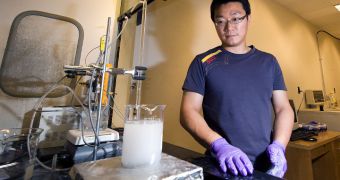Purdue University scientists announce the development of a new method for producing hydrogen, which extracts the chemical straight out one of the most abundant resources on the planet, seawater.
The approach, which could be used to extract sufficiently-large amounts of hydrogen to run engines on boats and ships, relies on breaking apart saltwater molecules, and extracting the fuel within.
Especially in marine applications, this new production method could put an end to the use of fossil fuel-based products, such as diesel and gasoline, the Purdue team says.
Distinguished professor of electrical and computer engineering Jerry Woodall says that this is the first time this method has been applied on seawater. Thus far, it was only demonstrated to work on freshwater.
The expert, who was the leader of the new investigation, says that the hydrogen produced through this method could conceivably be introduced directly inside combustion engines.
“This is important because it might have many marine applications, including cruise ships and tankers,” Woodall explains, adding that the stages of hydrogen storage and transport may be circumvented.
“We generate the hydrogen on demand, as you need it. It also eliminates the need to store fresh water when used for marine applications,” he adds.
The Purdue professor conducted the new investigation together with doctoral student Go Choi. He explains that there are secondary applications to the method as well.
According to Woodall, the wastes that are produced as hydrogen is being extracted from seawater can also become useful, when they are recycled via wind turbines and solar cells.
This basically means that the approach could be used as a innovative way of storing energy from solar and wind power, which is something that is notoriously difficult to do.
“Being unable to store energy from wind and solar has been a major limitation for those technologies because they don't work very well when the Sun isn't shining and the wind isn't blowing,” Woodall says.
“But if we converted energy from wind and solar into fuel for hydrogen-generation, we would, in effect, be solving this problem because the hydrogen could then be used to generate electricity, to run engines or fuel cells,” he adds.
Like previous approaches to splitting hydrogen, the new method relies on using aluminum for the job.
“Since aluminum is low-cost, abundant and has an energy density larger than coal, this technology can be used on a global scale and could greatly reduce the global consumption of fossil fuels,” Woodall concludes.

 14 DAY TRIAL //
14 DAY TRIAL //